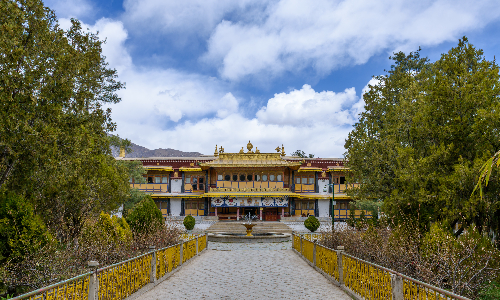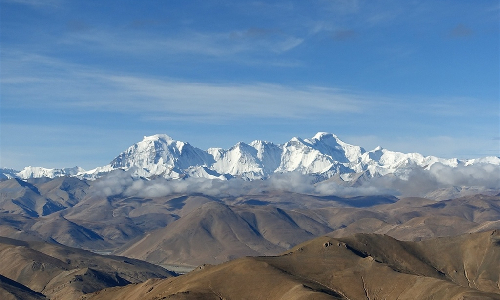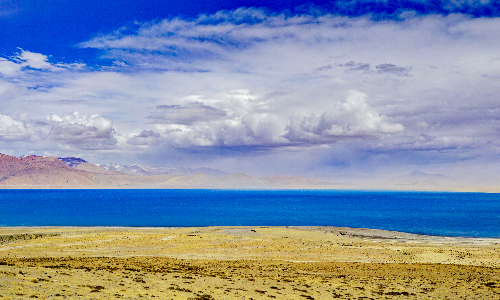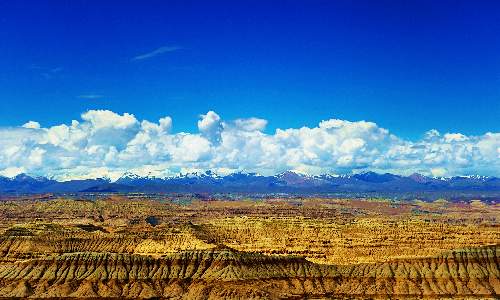The 16-day Tibet immersion tour will take you to the most remote western part of Tibet. With our private Tibetan guide, you will first visit some iconic Tibetan attractions like the Potala Palace and the Jokhang Temple. Along the way, you will also see some glittering turquoise lakes, such as Yamdrok Lake, Lake Paiku, Lake Manasarover, and Lake Rakshastal. Moreover, a trip to Mount Everest, the roof of the world, will accomplish one mission on your bucket list. Trekking in the Ngari area is also included in this 16-day Tibet itinerary. Numerous sacred mountains make Ngari known as a land of charm and magic that attracts millions of people to it. You may be impressed by the piety of devotees as well as the solemn scene with Tibetan prayer flags. You may be curious about the mysterious ancient civilization – Guge Kingdom Ruins, all of which contributed to the magic of Ngari. I know you are ready to challenge yourself, so come to join us!

Welcome to Tibet! Our local guide will meet you at the arrival hall with a big smile and a warm heart. You will be transferred to the hotel and the guide will help you to check in. The first day is crucial for visitors to Tibet. Although the scenery is beautiful, do not rush to get out and explore. The altitude of Lhasa is 3650 meters above sea level, and the oxygen content is only 70% of that in the mainland. Altitude sickness in varying degrees may happen to you. In addition to maintaining a normal state of mind, drinking plenty of water, eating plenty of fruits, and getting enough rest are ways to prevent or ease altitude sickness.
In the morning, your guide will meet you at your hotel lobby, and your Tibet tour will start! This morning you will first visit the Potala Palace. It is a symbol of Tibet and is regarded as one of the world’s top ten earth and wood structures. The main building is divided into the White Palace and the Red Palace. The White Palace is where the lamas live and engage in political activities. The Red Palace includes a Spiritual Pagoda and various Buddhist temples. To visit the Potala Palace requires following the religious customs of Tibetan Buddhism. The customs include not wearing a hat after entering, not taking pictures inside the palace (you can take pictures of the outside), not stepping on the threshold, etc.
And then, you will visit the Jokhang Temple. In Lhasa, the one that can make you feel the strongest religious culture of Tibet is the Jokhang Temple. It has a history of more than 1,300 years and was built in the Songtsen Gampo Period (629-650). Songtsen Gampo once married two princesses, one was Princess Wencheng of the Tang Dynasty and the other was Princess Shakyamuni of Nepal. Jokhang Temple was built to enshrine the statues of Sakyamuni brought by the two princesses.
After visiting the temple, you will walk along Barkhor Street. It is the epitome of the entire Tibet. Visitors can experience the primitive, mysterious Tibetan culture here and enjoy an afternoon at leisure! Barkhor Street is the most important place for Tibetan Buddhism believers to circle clockwise to pilgrimage. Once the specific time of pilgrimage comes, devotees will start to walk strictly clockwise along this circular road like they have received the same order. The pilgrimage time is in the afternoon, so if you are lucky, you will see this sacred scene. Barkhor Street is also one of the most distinctive locations for photography. Lots of eye-catching buildings, stalls and handicrafts with local elements will make you can't help but raise your camera. After today’s Tibet Lhasa tour, you will be transferred back to the hotel.


This morning we will continue our Lhasa tour. Please wear comfortable shoes today. You will first visit Drepung Monastery. Drepung monastery is the highest building, with a collection of castles, monasteries, palaces in one. With an area of about 200,000 square meters, it is the largest monastery of Tibetan Buddhism. The main building is the Main Assembly Hall, which can accommodate 8,000 people to chant sutras at the same time. The first Dalai Lama is from the Drepung monastery, so it has a very high status in Lhasa. There are many lamas in the monastery, and most of them are very friendly and warm. If you can visit the temple with accompany of a lama, you will get an in-depth understanding of the monastery.
After lunch, we will visit the Sera Monastery. The Buddhist scripture debate in Sera Monastery has a reputation abroad, and you will see that monks are active during the debate. After seeing so many Buddha statues and thangka murals, even though you don’t understand what they are saying, sitting on the sidelines and watching the monks debating, is also a spiritual cleansing for you.
Next, we will visit Norbulingka, an ancient garden in Tibet. It was built in 1751 with the permission of Emperor Yongzheng of the Qing Dynasty. Before 1951, it was the summer palace of Dalai Lamas. Now it has become a garden opened to the public. After the Lhasa city tour, you will be transferred back to the hotel.

 Shigatse
Shigatse Today we will transfer to Shigatse which is to the southwest of Lhasa. The whole trip needs to drive for about 5 hours (280KM). After the first 2.5 hours’ drive(110KM), we will visit Yamdrok Lake, which is called “Holy Lake”. Yamdrok means jade lake in the Tibetan language, from which you can feel its beauty before you see it. In light of the refraction, the lake presents different shades of color that are as beautiful as heaven. The total area of Yamdrok Lake is about 638 square kilometers, which is about 70 times the size of West Lake in Hangzhou. It is a dammed lake on the plateau, which was formed about 100 million years ago when the river was blocked by glacial debris flow. It is more than four thousand meters above sea level.
Then we will continue to drive for about 100 minutes(85KM) to see the Karola Glacier. It is located on the main road from Lhasa to Shigatse. Karola Glacier is the closest glacier to the road in Tibet, only 300 to 400 meters from the roadside. We can park the car on the side of the road and photograph the beauty of the Karola Glacier from a distance.
After an 80-minute drive(75KM), we will visit Pelkor Monastery. The construction of Pelkor Monastery started in 1418 and was completed in 1425. There are two main features of Pelkor Monastery. One of which is that there are three sects in the monastery, and they coexist peacefully. The other feature is the Bodhi Pagoda, also known as the One Hundred Thousand Buddhas Pagoda. It is the symbol of Pelkor Monastery. You will need to pay extra if you take photos in the One Hundred Thousand Buddhas Pagoda. But it’s worth it because you will be able to photograph 100,000 Buddha statues. Upon arrival in Shigatse, the guide will help you to check-in at the hotel.


 Mt. Everest
Mt. Everest After your breakfast, we will first visit Tashilhunpo Monastery. It is the largest monastery of the Gelugpa school of Tibetan Buddhism in Shigatse, and is the permanent residence of Panchen. You can see the spectacular palace complex at the entrance of the monastery. All the buildings with golden roofs above the white houses are the spiritual pagodas of Panchen. Spiritual pagodas are built to commemorate and worship eminent Panchen after they pass away. It is worth mentioning that there is a 900-square-meter Buddha display platform, where giant Thangkas are displayed during festivals. The giant platform was built in 1468 AD. Three days before and after May 15th in the Tibetan calendar every year, a grand Buddha exhibition is held at Tashilhunpo Monastery. The Thangkas of the Amitabha Buddha, the Sakyamuni Buddha, and the Qampa Buddha will be displayed on the platform. The monks and devotees will worship and pray here.
Then we will drive southwest to Mount Everest (Qomolangma). We will drive for about 7 hours, and the distance is about 340 KM. Now to protect the environment, Everest Base Camp has been closed to tourists indefinitely. But we can see Mount Everest at the Rongbuk Monastery. It is located at an altitude of 5154 meters. Looking south from here, it is an excellent place to see and photograph Mt. Everest. And you will know why Mount Everest is called the “Roof of the World” then. Since ancient times, the Tibetan people have respected Mount Everest as a god.
The Rongbuk Monastery is also worth a visit. With a history of more than 100 years, it was a special monastery with both monks and nuns. There is a stage in front of the main hall, and the local people come here to watch lamas’ performance during important festivals.
You will stay one night at the hostel of the Rongbuk Monastery. Accommodation condition here is limited because it is not easily accessible and few people come here.


 Saga
Saga Today, we will drive northwest to Saga county. Today we will drive for about more than 10 hours and 750KM in total. Saga means “lovely place” in the Tibetan language. There are more than ten small lakes, six geothermal hot springs in Saga. The local people usually bathe in hot springs to treat their common stubborn diseases, such as stomach problems, skin diseases, arthritis. The curative effect is quite good, so a lot of travelers are attracted to visit here.
First, we will drive for about 4 hours and 40 minutes(280KM) to see Mt. Shishapangma. It is the only mountain over 8,000 meters above sea level that belongs entirely to China. Situated in the back-land of the Himalayas, Mt. Shishapangma is about 120 km away from Mount Everest. It is ranked 14th out of all the peaks over 8,000 meters above sea level in the world. Three kilometers east of the main peak is Moramenching Peak. According to local legend, Shishapangma Peak is a glamorous goddess, and Moramenching is her husband, while a flat-topped mountain on the north side is her valentine. In a duel with her valentine, Moramenching chopped off the head of his rival in love. The mountain has become flat-topped since then.
After that, we will continue to drive for about 2 hours and 20 minutes(150KM) to visit Lake Paiku. It is the largest inland lake in the Mount Everest protected area. It has an area of about 300 square kilometers and is 4,590 meters above sea level. The lake is surrounded by mountains on three sides. Lake Paiku is rich in fish resources. And if lucky enough, you are very likely to see wild animals such as wild horses, Tibetan wild donkeys, Tibetan antelope, cranes, yellow ducks, and gray ducks. Standing at the lakeside, the whole lake seems to become one with the blue sky.
At last, we will drive for about 5 hours (350KM) to Saga county, and stay there overnight.


 Darchen
Darchen This morning we are heading to Darchen which is to the northwest of Saga. The whole trip needs to drive for about 13 hours and 900 kilometers. Darchen is a small village at the foot of Mt. Kailash. It is the beginning and ending place of the Ngari pilgrimage, from where many devotees depart every year towards the faith in their hearts. After 12-hour drive (about 850KM), as we passing through the dividing line between Shigatse and Ngari-the Mayomla Pass, you will see the spectacular views of Mt. Naimonanyi which is known to Tibetans as the “Goddess Mountain”. It is 7694 meters above sea level and is located in the western section of the Himalayas. The Mt. Naimonanyi is opposite the 6638-meter Mount Gang Rinpoche.
Then we will continue to drive for about 45 minutes(50KM) to see Lake Manasarover. You will see gorgeous natural scenery near the lake. It is regarded as the center of the holy land since ancient times. Buddhism believers regard it as one of the three big “god lakes” in Tibet.
Then we will see Lake Rakshastal which is next to Lake Manasarover. “Lake Rakshastal” means “poisonous black lake” in the Tibetan language. Since its lake water is not drinkable by humans and animals, the locals consider it poisonous. This is why it is so named. In fact, it is a brackish lake, so its water is not drinkable. Although the two lakes are very close to each other, Lake Manasarover is a freshwater lake, while Lake Rakshastal is a brackish lake. This is also an interesting phenomenon.
Finally, we will arrive at the southern foot of Mt. Kailash. Mt. Kailash is recognized as a sacred mountain in the world and is also regarded as the center of the world by Hindu and Tibetan Buddhists. Mt. Kailash, Mt. Naimonanyi, Lake Manasarover, and Lake Rakshastal are called “sacred mountains and holy lakes” by Tibetan people, and the Mt. Kailash is known as the king of sacred mountains. If we are very lucky to arrive at the foot of the mountain at sunset, we will see the light of the sunset shining on the top of the mountain. It will let you feel that the mountain is covered by a beautiful veil, which makes it mysterious and sacred. At last, you will be transferred to the guesthouse in Darchen and check in.


 Drirapuk
Drirapuk Today we will be traveling from Dachen to Drirapuk to start the pilgrimage. We will drive for about 25 minutes(7KM)and then trek 13KM. The trip will pass through the Sarshung Valley. There will be yaks and porters who can be hired in Sarshung village on the way to Drirapuk. Kindly note that the cost of hiring yaks and porters is not included. We will eventually enter and spend the night at the Drirapuk Monastery. This monastery is the best place to see the north side of the sacred mountain, Mt. Kailash, and is also a place for people to overnight.


 Dzutripuk
Dzutripuk After breakfast, we will set off from Drirapuk Monastery. Today’s trek is the most difficult and the whole distance is about 18KM. You will trek from 4600 meters to 5700 meters above sea level. The tilt of our starting place is 20 degrees. When trekking over Dromala Pass, the 60-degree rampway is the hardest part of the whole trek.
Before you reach the pass, you will first see the famous celestial burial ground. It is the most famous and most sacred celestial burial ground in Ngari. Celestial burial is a traditional way of burial. After the death of a person, the corpse is transported to a designated place for vultures (or other birds, beasts, etc.) to eat. The core theory of Tibetan celestial burial is immortality and reincarnation of soul. They believe that death is just the separation of the immortal soul from the body. Tibetans admire celestial burials, and they believe that feeding vultures with their bodies is the most noble alms. Therefore, everyone desires to send his or her body here for a celestial burial after they have left this world to fulfill their last wishes. Devotees usually leave behind a drop of blood, a tuft of hair, or a piece of clothing on the ground. This is a sign to indicate a farewell to past suffering and the beginning of a new life.
The journey from the celestial burial ground to Dromala Pass is about 3.4KM, which is the most strenuous and physically demanding part of the entire route. You’ll reach the Dromala Pass when you see the colorful Prayer Flags all over the place.
When we walk downhill, you will see Kadoe Lake. It is verdurous and known as the Lake of Mercy. It is said that bathing in this lake can cleanse people’s souls. I don't recommend you take a bath here because the temperature is very low and getting sick at such a high altitude can be real trouble.
We may also visit Zutulpuk Monastery that is the third temple on the route of pilgrimage. The monastery is surrounded by numerous stone scriptures, various statues of Buddha, and so on. A short distance south of the monastery, there is a spring. Devotees believe that drinking from this sacred spring can get a blessing from nature.


 Darchen
Darchen Today we will trek about 7KM to Zongto, and then you can take the bus to Darchen. You will see many Mani Stones along the Kora mountain. Devout Tibetan Buddhists always believe that if they continuously and persistently engrave “Om Mani Padme Hum” on Mani stones, these stones will have a supernatural spirituality that will enable them to cleanse the “sins” of their life. We will end the trek around noon, and you can have a rest at the hotel of Darchen.
 Zanda
Zanda After waking up naturally and having breakfast, we will head to Zanda county which is to the northeast of Darchen. The whole trip needs about 4 hours by car. And the total distance is about 240KM. We will first visit Zanda Earth Forest National Geopark. It is a unique landscape formed by the erosion of flowing water and is about 1100 years old. The Zhada Earth Forest is the most typical, best preserved, most peculiarly shaped, and most widely distributed tertiary stratigraphic weathering-formed earth forest landform found in the world. It is also the site of palaces and monasteries of the Guge Kingdom.
After that, we will transfer to Tholing Monastery. Tholing Monastery was built in the 9th century and was the first Buddhist center of the Guge Kingdom (9th – 17th century). The architectural style and frescoes of the Tholing Monastery are full of characters of Nepal and India. The terrain around the temple is flat and there were many monks' houses, but now they are residential houses.
We then proceed to the Guge Kingdom Ruins, about 20 km west of Zanda County. This site is on a hill. The ruins of the Guge Kingdom are over 300 meters high from the foot of the hill to the top. There are more than 600 houses, pagodas, and caves. Five well-preserved temples and halls can be seen here. Visiting inside the temples, clay Buddha statues and murals, as well as the portraits of tsenpos and princes of the past dynasties are remaining in the temples.
Today, we will overnight at Zanda county.


 Saga
Saga Today we will get up around 7:00 in the morning. We will drive to the foot of the Guge Kingdom again to enjoy the breathtaking scenery of the sunrise. Then we will take around 10 hours(700KM) to Saga which is to the southeast of Zanda and spend the night in Saga.
 Sakya
Sakya This morning, we will transfer to Sakya which is located to the southeast of Saga. It will take around 6 hours(350KM). Tonight, we will stay at the guesthouse at Sakya.
 Shigatse
Shigatse In the morning, we will visit the ancient Sakya county and the Sakya Monastery. Sakya Monastery is the first monastery of the Sakya sect. Sakya sect is one of the main sects of Tibetan Buddhism. The main colors of the wall here are red, white and cyans. Red represents Manjushri Bodhisattva, white symbolizes Guanyin Bodhisattva and cyan symbolizes Vajradhara Bodhisattva. The monastery houses precious Great Tibetan Sutra, Yuan Dynasty murals, ancient porcelain and other cultural relics.
At last, we will drive northeast for about 2.5 hours(150KM) to Shigatse and overnight.


 Lhasa
Lhasa Today we will drive northeast for about 4.5 hours(280KM) to Lhasa. On the way, you will see the Yalong Valley. You can stand on the viewing platform and see the vast Yalong River. You may also have a chance to see the watermill that is used to produce the Tibetan incense is made. We will spend the night in Lhasa.


The 16-day Tibet immersion tour is coming to an end. Although the Tibet journey is over, the memories will live on forever in everyone’s hearts. Our guide will take you to the airport and help you with the check-in. Hope we have a chance to meet again.
Editor: Summer Hou
Proofreader: Betsy He
| City | Five Star hotel list | Four Star hotel list |
|---|---|---|
| Lhasa | Shangri-La Hotel Lhasa | Thangka hotel |
| Other Cities | Guest House | Guest House |
 |
![]() About your child or infant, please contact us for a discounted price.
About your child or infant, please contact us for a discounted price.



We started with a few days in Beijing & ended in Shanghai, from where we visited the Forbidden City and Great Wall. In between we visited Terra Cotta Warriors Museum, Panda Base, Shanghai Disneyland.

We had a wonderful holiday in China which will remain long in the memory. China is a breathtakingly beautiful country full of splendid temples and palaces, mountains and rivers, peaceful rural scenes and bustling shopping streets.
 QUICK ENQUIRY
QUICK ENQUIRY